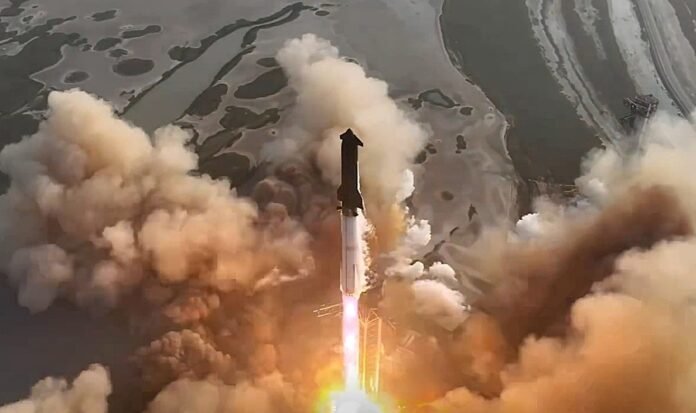SpaceX’s Starship super-rocket got off to a great start today for its ninth flight test, but the second stage ran into a host of issues and made an uncontrolled re-entry.
The 400-foot-tall rocket’s first-stage booster, known as Super Heavy, rose from its Starbase launch pad in Texas just after 6:30 p.m. CT (2330 UTC) with all 33 methane-fueled engines blazing. Cheers erupted from SpaceX’s teams in Texas and at the company’s HQ in California.
But the second stage, known as Ship, wasn’t able to open its payload doors for what would have been Starship’s first-ever payload deployment. The plan had called for Ship to send a set of eight Starlink satellite simulators into space. Instead, the experiment was scrubbed.
Minutes later, the Starship team got worse news: As the Ship headed toward a planned splashdown in the Indian Ocean, it began spinning uncontrollably. SpaceX commentator Dan Huot said the second stage lost attitude control, apparently due to propellant leaks.
“Not looking great with a lot of our on-orbit objectives today,” he said. Ship broke up as it descended over a wide swath of open ocean that had been cleared for the splashdown.
Starship is considered the world’s most powerful rocket, with liftoff thrust of 16.7 million pounds. That’s more than twice the oomph achieved by the Saturn V rocket during the Apollo era’s heyday.
A version of Starship is slated for use as the landing system for NASA’s Artemis 3 mission, which would mark the first crewed moon landing since Apollo. SpaceX also aims to use Starship for missions to Mars. During today’s webcast, Huot said Starship flights to the Red Planet could begin as early as next year.
In order to meet that ambitious schedule, SpaceX has to demonstrate that Super Heavy and Ship can execute all the complex maneuvers that will be necessary — including controlled landings of both stages, and the ability to deploy payloads and refuel in space.
During the seventh and eighth flight tests, SpaceX successfully recovered the first stage at its launch pad, using an ingenious system that captured the autonomously controlled Super Heavy booster with a pair of giant mechanical arms known as “chopsticks.” But in both those cases, the second stage was lost during its flight in space.
The investigations into those mishaps, overseen by the Federal Aviation Administration, went on for months. In each case, SpaceX said it upgraded its hardware and operating procedures to address the failures. Last week, the FAA gave the go-ahead for today’s test.
The objectives for today’s flight included a set of challenging maneuvers that were conducted by Super Heavy after stage separation — including a directional flip-over and a heightened angle of attack, both of which are aimed at making future missions more fuel-efficient. Super Heavy also tested its ability to make a controlled descent even in the event of a single-engine failure. Because of the extreme challenges involved, SpaceX made no plans to recover the booster but instead let it fall into the sea near Texas’ Gulf Coast.
All those tests appeared to go well, which was an impressive achievement — especially considering that this was the first Super Heavy booster to be flown more than once. (It was previously used in January for the seventh Starship flight test.)
The FAA said it was aware of the anomaly that occurred during today’s flight and was “actively working with SpaceX on the event.”
“There are no reports of public injury or damage to public property at this time,” the FAA said in an emailed statement.
In a posting to his X social-media platform, SpaceX CEO Elon Musk signaled that he wouldn’t be deterred by today’s setbacks.
“Starship made it to the scheduled ship engine cutoff, so big improvement over last flight! Also, no significant loss of heat shield tiles during ascent,” Musk wrote. “Leaks caused loss of main tank pressure during the coast and re-entry phase. Lot of good data to review. Launch cadence for next three flights will be faster, at approximately one every three to four weeks.”


